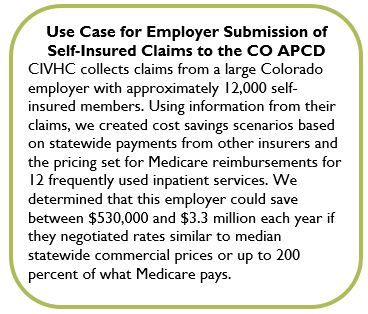![]() There are many small things that we do today that can have a big impact on us later in life. From signing up for the 401k at work to taking the stairs every day, little actions can add up. We could say the same thing to self-insured employers about submitting claims to an All Payer Claims Database (APCD). By choosing to submit claims to an APCD, employers can take a simple step that will benefit them for years to come.
There are many small things that we do today that can have a big impact on us later in life. From signing up for the 401k at work to taking the stairs every day, little actions can add up. We could say the same thing to self-insured employers about submitting claims to an All Payer Claims Database (APCD). By choosing to submit claims to an APCD, employers can take a simple step that will benefit them for years to come.
What’s a self-insured employer?
Self-insured employers pay their employees’ health care claims out of pocket, as they occur, rather than contracting with an insurance company for a standard health plan. They are usually very large companies with thousands of employees who decide to self-insure for a number of reasons, including:
- Ability to customize their plan for their workforce
- Not pre-paying for coverage
- Are free to contract with providers of their choosing
Typically, self-insured employers have a third-party administrator (TPA) who handles processing and paying the claims. Some of these employers fall under the Employee Retirement Income Security Act (ERISA), which established required practices to protect members’ investments.
ERISA self-insured employers have different reporting rules than other insurers like Medicare, Medicaid, and commercial plans. In March 2016, the United States Supreme Court ruled that states could not mandate the submission of health care claims from ERISA-based self-insured employers. This means that states with an APCD could no longer require claims from these employers, potentially creating a big gap in the completeness of the databases and some blind spots in analyses of health care cost and services.
A Choice
ERISA-based self-insured employers can voluntarily request their claims to be submitted to APCDs in order to reap the benefits of analyses possible with cross-payer and provider data. These benefits could lead to identifying ways to improve health for their employees and achieve significant cost savings. These benefits would also allow researchers and policymakers to see the true scope of health care across states and the country and then, backed with evidence, begin improving the health care system for us all.
 In Colorado, the process is simple. The steps for initiating voluntary submission to the Colorado APCD are outlined below (these steps are not legal advice; please speak with counsel before beginning):
In Colorado, the process is simple. The steps for initiating voluntary submission to the Colorado APCD are outlined below (these steps are not legal advice; please speak with counsel before beginning):
- Opt-in Form: Submit the Voluntary Submission Opt-in Form to ColoradoAPCD@civhc.org, and CIVHC will share it with your TPA or administrator to let them know you wish to have your data submitted to the CO APCD.
- BAA with TPA/Administrator: Typically, self-insured employers have a business associate agreement (BAA) in place with their TPA or administrator. These agreements may already support voluntary CO APCD data submission; if it doesn’t, you can request submission via a simple update.
- Data Sharing Agreement with CIVHC (optional): CIVHC has a Data Sharing Agreement available for voluntary data contributors that clearly identifies CIVHC’s role as the CO APCD Administrator and spells out our commitment to protecting and treating voluntary CO APCD data submissions.
Once voluntary submission is set up, no further action is needed. Claims will be submitted to the CO APCD and available for custom analyses to inform lowering costs while improving care.
If you have questions about voluntary submission to the CO APCD please email us at ColoradoAPCD@civhc.org.

